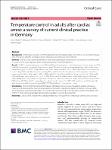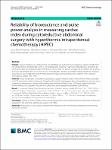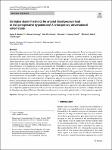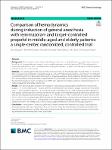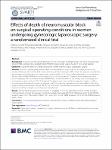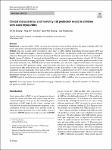Search
Author
- Daqing, Ma (3)
- Alexis, Ferré (2)
- Anna, Lybeck (2)
- Ashish K., Khanna (2)
- next >
Subject
- intensive care unit (8)
- acute respiratory dist... (5)
- chronic obstructive pu... (5)
- ICU (5)
- next >
Date issued
Has File(s)
Search Results
Temperature control in adults after cardiac arrest: a survey of current clinical practice in Germany Temperature control is recommended after out of hospital cardiac arrest (OHCA) by international guidelines. This survey aimed to investigate current clinical practice and areas of uncertainty. |
urgically managed appendicitis exhibits great heterogeneity in techniques for mesoappendix transection and appendix amputation from its base. It is unclear whether a particular surgical technique provides outcome benefit or reduces complications. |
Several prediction models of survival after in-hospital cardiac arrest (IHCA) have been published, but no overview of model performance and external validation exists. We performed a systematic review of the available prognostic models for outcome prediction of attempted resuscitation for IHCA using pre-arrest factors to enhance clinical decision-making through improved outcome prediction. |
Various malignancies with peritoneal carcinomatosis are treated with cytoreductive surgery and hyperthermic intraperitoneal chemotherapy (HIPEC). The hemodynamic instability resulting from fluid balance alterations during the procedure necessitates reliable hemodynamic monitoring. The aim of the study was to compare the accuracy, precision and trending ability of two less invasive hemodynamic monitors, bioreactance-based Starling SV and pulse power device LiDCOrapid with bolus thermodilution technique with pulmonary artery catheter in the setting of cytoreductive surgery with HIPEC. |
Arterial blood pressure is one of the vital signs monitored mandatory in anaesthetised patients. Even short episodes of intraoperative hypotension are associated with increased risk for postoperative organ dysfunction such as acute kidney injury and myocardial injury. Since there is little evidence whether higher alarm thresholds in patient monitors can help prevent intraoperative hypotension, we analysed the blood pressure data before (group 1) and after (group 2) the implementation of altered hypotension alarm settings. |
Remimazolam confers a lower risk of hypotension than propofol. However, no studies have compared the efficacy of remimazolam and propofol administered using target-controlled infusion (TCI). This study aimed to investigate hemodynamic effects of remimazolam and target-controlled propofol in middle-aged and elderly patients during the induction of anesthesia. |
To assess radiological and functional outcomes of transilial internal fixator (TIFI) for treatment of sacral complete transforaminal fractures with a novel implantation technique that decrease wound irritation problems in addition to facilitating easy application of reduction methods beside showing the best entry points, screw trajectories and angles. |
The Sequential Organ Failure Assessment (SOFA) score was developed more than 25 years ago to provide a simple method of assessing and monitoring organ dysfunction in critically ill patients. Changes in clinical practice over the last few decades, with new interventions and a greater focus on non-invasive monitoring systems, mean it is time to update the SOFA score. As a first step in this process, we propose some possible new variables that could be included in a SOFA 2.0. By so doing, we hope to stimulate debate and discussion to move toward a new, properly validated score that will be fit for modern practice. |
In recent years, the relationship between the advantages and disadvantages of a deep neuromuscular block (DNMB), compared to a moderate block (MNMB) in laparoscopic surgery, has been increasingly studied. |
Acute myocarditis (AMC) can cause poor outcomes or even death in children. We aimed to identify AMC risk factors and create a mortality prediction model for AMC in children at hospital admission. |

